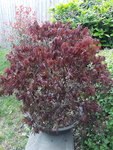The spray was a very small amount of Dawn dish soap and water. I spraying the leaves only, but I imagine some went into the soil.
Dawn is a detergent, not a soap. Also it is not an insecticidal soap. When spraying an insecticidal soap it is a topical insecticide. In other words, you want to be spraying the insects, and not the tree or plant. Easier said than done, I know, but insecticidal soaps can actually damage plant foliage by removing or thinning the cuticle - the wax coating on leaves - which protects a tree from dehydrating. This is a short way of saying - when you spray a tree with a Dawn detergent solution you may actually be drying out the leaves.
This is just a suggestion because I don't know how strong of a detergent solution you used. However Japanese maple leaves are relatively tender when they first emerge from the bud, so you should try to avoid spraying them with a chemical if you aren't 100% certain it won't harm the leaves. If you see aphids, first try to physically remove them by just spraying the tree with water. Next, check for ants, because in many cases the aphids are being brought by ants. Otherwise consider an organic insecticidal product like
pyrethrins (made from chrysanthemum) which won't harm your plant.
Stay away from home remedies on the Internet

I hope I am right because minor wilting caused by dehydration should be easy to counteract. Just rinse off the detergent and protect the tree from direct sun and wind, and wait for the tree to recover.



